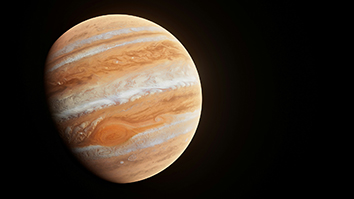
SRI has a long history of working on space-related projects, starting in the 1960s.
Under the icy surface of Jupiter’s moon Europa, a massive saltwater ocean may hold the necessary conditions for life. NASA’s Europa Clipper mission, slated for launch this fall, is headed to the distant moon to determine if and where these conditions might exist. As the spacecraft performs close to 50 flybys of Europa, it will use imagers designed by SRI to map almost the entire surface of the moon.
The Europa Imaging Systems (EIS) includes two cameras, both of which rely on an eight-megapixel sensor designed at SRI’s Center for Advanced Imaging. The wide-angle camera will capture stereo and color images of the landscape along the ground tracks during the spacecraft’s flybys of Europa.
The narrow-angle camera provides more detailed views of specific areas at the meter scale (a few feet), as well as providing near-global mapping and carrying out searches for potential active plumes. SRI’s complementary metal oxide semiconductor (CMOS) imagers will convert the light collected by these cameras into stereoscopic and color images, revealing valleys and ridges of Europa’s surface in greater detail than ever before.
“It takes a small village of engineers, scientists, technicians, and managers to put a camera like EIS into orbit,” said David Keller, the program manager on the EIS project and SRI director of space imaging programs. “The SRI team thanks our colleagues at the Johns Hopkins Applied Physics Laboratory (APL) and NASA’s Jet Propulsion Laboratory (JPL) for the opportunity to be part of this exciting mission of discovery.”
EIS will map around 90 percent of Europa’s surface, at better than 100-m (100-yard) pixel scale — to date less than 1% of the surface has been imaged at comparable resolution by the Galileo spacecraft. The goal is to study features across Europa’s surface, the unique geology of which might hint at what’s happening underneath the ice.
Some surface structures might show signs of recent geologic activity, for example, or locations where plumes from the subsurface ocean are venting material into space. The color images will also help provide insight into what Europa’s surface is made of.
“It takes a small village of engineers, scientists, technicians, and managers to put a camera like EIS into orbit.” — David Keller
In addition to designing the imagers, researchers at SRI also designed and assembled the package that houses them and conducted an extensive battery of tests to ensure that the imagers were ready for their trip across our solar system.
In addition to the CMOS sensors being radiation-hardened by design, the spacecraft will protect the sensors from Jupiter’s intense radiation by a centimeter-thick aluminum vault that encases all the mission’s electronics, but there are plenty of other stresses that they need to be able to handle.
SRI demonstrated that the imagers could survive the extreme heat, cold, and radiation in the vacuum of space and would be able to generate high-quality images for the entire duration of the mission.
SRI has a long history of working on space-related projects. Among them:
- SRI provided the CMOS imagers for NASA’s Parker Solar Probe, which launched in 2018 and is currently orbiting closer to the sun than any spacecraft before it.
- SRI is working under contract with IARPA to detect and track small debris in space that could cause damage to satellites or other spacecraft.
- SRI space startups, including LEO Labs, Nuview, XONA, and Zephr, are working on protecting objects in orbit from debris and collisions, building satellites that map the Earth’s surface with LiDAR, creating new satellite-based navigation systems, and improving GPS accuracy.
- SRI’s Dish missions helped gain insight into Soviet technology and contributed to Pioneer missions for NASA. Today, the U.S. Navy is working with SRI to experiment with the Dish to understand RF exploration for space and aircraft.
Europa Clipper, expected to launch in the fall of 2024, will take about six years to reach orbit around Jupiter, and then perform 50 close flybys of Europa. The images collected by the EIS will complement other data gathered by the spacecraft during this time, including thermal, infrared, and ultraviolet imaging, magnetic field measurements, radar sounding, and chemical analysis.
Together, this data from Europa Clipper’s investigations will provide insight into the habitability of this ocean world in the outer solar system and potentially inform further missions exploring the possibility of life beyond the boundaries of Earth.
Learn more about our innovations in space.



